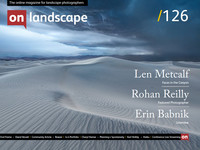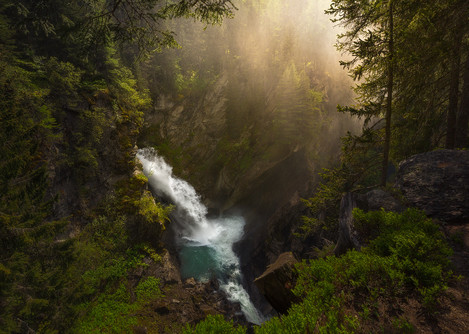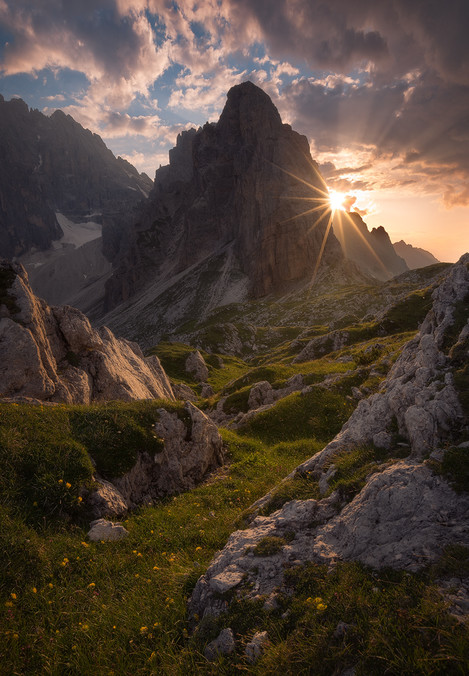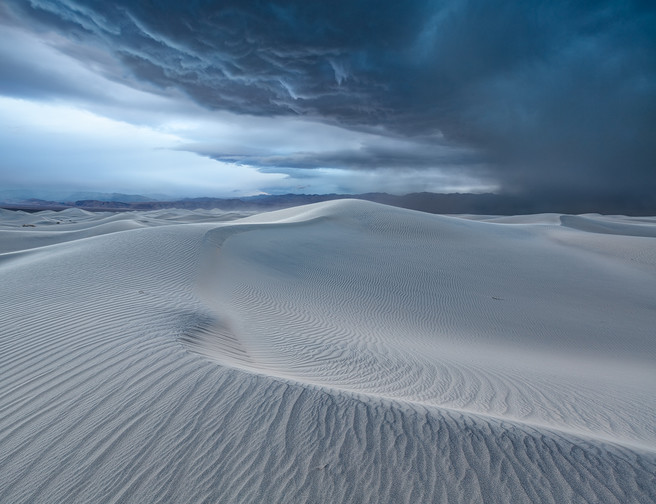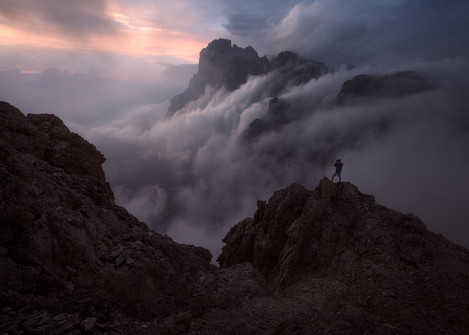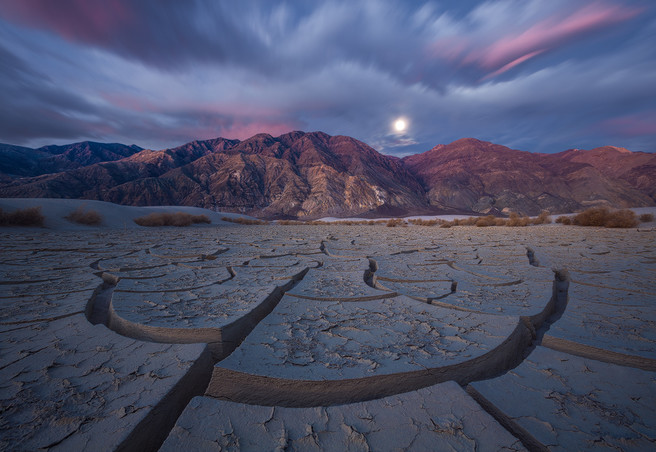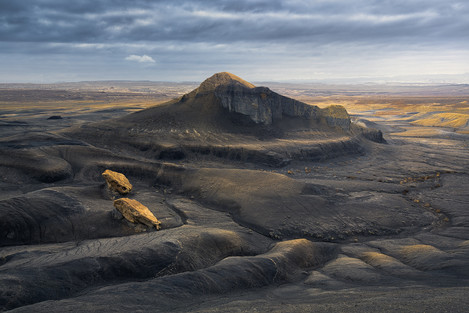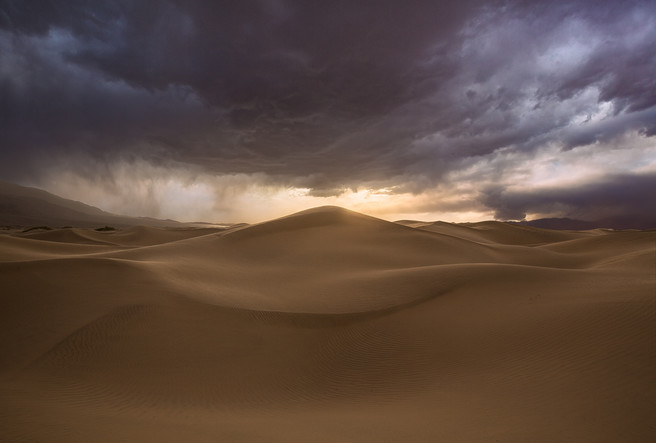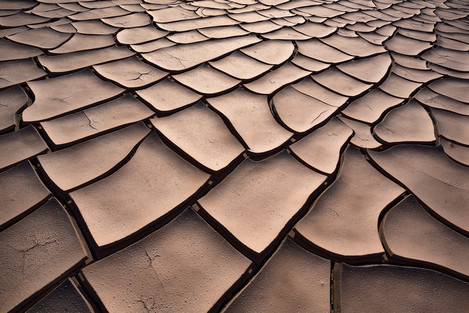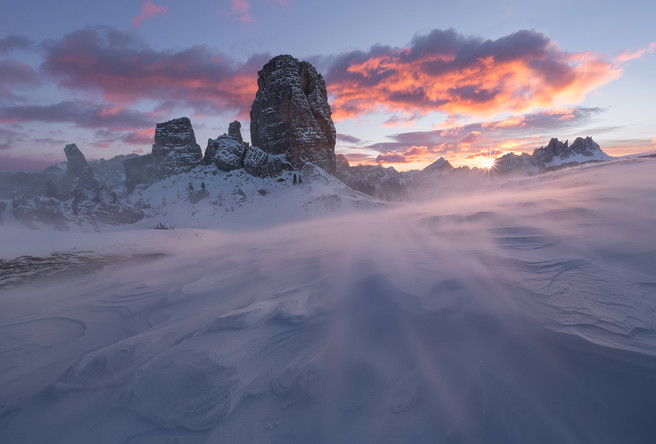From History of Art to Contemporary Visions

Erin Babnik
Drawing upon her background in art history, she brings a deep knowledge of aesthetics, visual communication, and cultural relevancy to her landscape photographs

Tim Parkin
Amateur Photographer who plays with big cameras and film when in between digital photographs.
In two weeks time our landscape photography conference begins and we are very proud to be bringing Erin Babnik over from the US to talk. Erin's work has an intriguing balance of the classic sublime but without the level of bombast that this sub-genre of landscape typically engenders. We asked Erin a few questions about her photography and background. If you like what you read, please come and see her talk titled "Life Lessons for Creative Expression" on Sunday at the Meeting of Minds conference (or watch it via live streaming!).
You entered photography via a fairly unusual route, documenting archaeological digs while completing a history of art dissertation. Does your history of art background affect your approach to photography and can you pick three artworks that were and/or are still influences in your creative work?
Although I was photographing while participating in archaeological digs, it was always someone else who had the job of documenting those excavations, and the photographs that I made were for my own research and teaching archive. What I needed was a collection of images that communicated whatever I found important about particular artifacts or architectural remains, and I traveled widely to archaeological sites and museums to produce that collection. For example, because my specialty was ancient Greek sculpture, I often needed angles of statues and certain lighting for them that helped me to explain my own interpretations of the artworks. Likewise, with photographing archaeological sites, I typically wanted to convey the context and display conditions of sculptures so that I could explain how these settings might have affected artistic decisions and viewer reception. So documentation per se was never really the name of the game for me.
That emphasis on interpretation carried over quite naturally into my creative efforts once I began devoting my time to landscape photography. Because of my training in visual analysis, I tend to see metaphors and stories in nature scenes quite readily. My background also has instilled in me a tendency to see natural features as abstract sculptures of a sort. Mountains especially can seem to gesture, catch the light, and occupy space much in the way that statues do, and I often find myself amused by such observations and inspired to compose or to develop a photograph according to them.
As for specific artworks that have inspired me, the first that come to mind are Hellenistic Greek sculptures. There are many that have enchanted me over the years, including the Nike of Samothrace, the Laocoön Group, and the Ludovisi Gauls. Although Hellenistic sculpture is sometimes dismissed as overwrought and excessively emotional, I have always enjoyed the art works that I mentioned for their theatricality, profundity, and emphatic visual treatments. They are also virtuoso works of composition and craftsmanship. These qualities are ones that I tend to strive for in my photography.
I presume your art history education came later in life, what inspired you to venture in this direction?
Yes, I had a successful career as a graphic designer and creative director for many years before deciding to enrol in art school so that I could take that career to an even higher level. While continuing to work full-time, I took classes on everything from figure drawing to art history and found myself especially fascinated by the latter. I realised that writing, one of my early passions, had no place in my current career, and I craved more of it. I also really enjoyed teaching and wished that I could practice it at a higher level. At that point I was working side jobs as a Photoshop instructor at a few different art institutes and had grown quite jaded by the technical nature of teaching software; I wanted to engage with students about ideas, not about buttons and sliders. When art history got me into photography, I ultimately realised that leaving graphic design had gained me the stimulating writing and teaching that I desired at the expense of having an outlet for creative expression. Now as a full-time photographer, I get to enjoy it all!
Your previous career was a graphic designer, and we have interviewed a disproportionate number of people who have experience in this industry. Do you think a lot of what we think of as composition is actually graphic design and what are the main elements of graphic design that you bring to photography (e.g. white space, typography, colour)
All art forms have certain visual principles in common, and I don’t believe that any of those principles really belong to any particular medium. For example, light and dark areas in any medium will determine emphasis or recession; strong lines will suggest movement; textures will add differentiation and visual interest; and so forth, regardless of whether we are talking about sculpture, painting, photography, or graphic design. Even the introduction of colour has parallels across mediums, adding a layer of aesthetic complexity to any essential forms of an art work. Since I have devoted many years to the study of art works of every medium, I don’t feel as though I can specify any tendencies in my photography that I owe to graphic design in particular. I suppose that if I had to choose one, however, it might be my interest in the visual hierarchy. I have written quite a bit on the concept of hierarchy and its application in landscape photography, and I tend to compose my own photographs in a hierarchical manner. Although studying art history did a lot to help nuance my ideas about hierarchy, my own photographic habits with it probably did develop largely out of my years of working as a graphic designer.
Do you think your painting experience has informed your photography in terms of the experience of culture, different approaches to picture building and composition?
If there is anything that I have carried over from my years as a painter, it is probably my approach to post-processing. When I painted with oils, I liked to apply layers of tinted glaze, slowly building up differences in tonality and colour. I work very similarly with layers in Photoshop as my method of dodging, burning, and editing colour. Editing this way allows me to have control over very subtle variations in tones and hues, and it allows me to target areas of a photo very selectively.
Also, some of the techniques that I employ in my photography do require a certain level of ‘construction’, taking different exposures with the intention of combining them into a presentation of a scene that is more representative of my experience than what I could achieve otherwise. For example, I might combine different shutter speeds, stitch together frames for a greater field of view, or blend together different focal points for greater depth of field. Of course, this approach to creating a final photograph can be quite laborious, but once you have spent months creating a single oil painting, a few days in Photoshop seems like nothing!
The culture of painting is also ingrained in me now, causing me to have fairly liberal ideas about topics such as manipulation in landscape photography. Although my own practices tend to be relatively conservative, I am certainly no purist, and I’m very supportive of photographers who choose to express their ideas about nature in ways that I might not.
You’ve traveled to some quite varied landscape (especially varied in temperature!) which do you feel is ‘your’ type of location where you feel most creative and at home?
I am probably most at home in alpine environments, although desert regions run a close second. Some of my first memories are of experiences in the mountains of California, where my family lived when I was very young. According to my mother, one of my first drawings for a school assignment showed our house with clouds beneath it, an oddity that caused my kindergarten teacher to express concern about me. My mother had to assure the teacher that we did indeed live above the clouds! Given the environment of my upbringing, it is probably unsurprising that I would be drawn to the exploration of mountainous areas as a photographer.
Similarly, I think that my years of doing archaeological fieldwork in the Middle East instilled in me a great appreciation for some of the aesthetics that I now feature in my photographs of desert locations. Ironically, though, I do not gravitate much towards coastal areas for photography, even though I spent most of my summers as a preteen and teenager living aboard a boat on the California coast.
Your work fits into a ‘school’ of photography that has quickly gained ground in the US. That being the use of forced perspective, post processing techniques of painting with light, blending components in different and creative ways. The results speak for themselves but do you think that a lot of the conversation around this genre takes the focus away from consideration at the moment of capture?
I suppose that it’s fair to say that my work fits in with that school, although I have an unusually restrained style of employing such techniques. Conversations that address progressive post-processing do often miss the point that most of these techniques require pre-visualization and deliberate decisions at the moment of capture. There can be no focus-stacking without shooting multiple focus points in the field, for example. Likewise with a “perspective blend”, which results in a composition that is not visible all at once through the camera, the ‘pieces’ for it have to be pre-visualized as a whole and photographed accordingly. So when I see these techniques characterised as some kind of retrofitting cooked up while sitting behind a computer, it is clear to me that the techniques are easily misunderstood, causing people to be unaware of how it all comes together and that these decisions mostly originate at the moment of capture.
Near/Far compositions are a relatively new thing in photography that came about in the 1960/70’s with the availability of small cameras with very wide angle lenses (I’m thinking David Muench). Why do you think this sort of representation hasn’t really been seen in art before (or if it has can you talk about it)? If it hasn’t been seen before, have wide angle lenses given us a new way of seeing the world?
Near/Far compositions are essentially solutions for making certain details of a scene more understandable. For example, by enlarging the scale of foreground flowers relative to a mountain peak in the background, we can show the details of those flowers to the extent that we would understand them while experiencing a place. When we get a good look at small details of nature and then gaze over them to features beyond, the brain puts it all together as the eye darts around. So bringing a foreground ‘close’ can help to replicate the actual experience of being in a place and understanding its smaller features within a larger context, allowing those features to have greater value within the scene’s hierarchy of meaning.
Manipulating scale to facilitate understanding is nothing new in art. I can think of countless examples in ancient art, such as the victory stele of Naram-Sin from the third millennium B.C. It depicts soldiers engaged in battle on the steep slopes of a mountain, with the figures and tree made enormous relative to the mountain, allowing viewers to appreciate the narrative of the scene much more easily than would be possible if the figures and tree were tiny specks dotting the slopes. Perhaps an example that aligns more closely with landscape photography would be the famous Nile Mosaic of Palestrina (ca. 100 B.C.), which shows local flora enlarged massively in relation to other details, right alongside the use of orthogonals in instances of herringbone perspective. So in the case of the mosaic, the artist was clearly concerned with creating a sense of real space while also allowing the smaller features of each scene to be legible.
The introduction of linear perspective and the use of mirrors and lenses to aid image-making obviously had an enormous effect on pictorial representation, long before the birth of photography. What ensued was a widespread adherence across mediums to the aesthetics of available optics. To my mind, the developments in optics and imaging that ushered in the age of Near/Far compositions have enabled a return to an ancient mode of representation. In that sense, it is not so much a new way of seeing the world as it is a new aesthetic within the medium of photography.
You talk a lot about finding the meaning in your photographs. Can you give examples that go beyond the obvious adjectives and statements frequently used (i.e. loneliness, adversity, ecological messages)
Sure, there are a number of ways that photographs can convey ideas, but I tend to be most interested in how they can suggest stories and metaphors that evoke universal human experiences, the great concerns of mankind that play out in all cultures to some extent. Those concerns might boil down to the types of adjectives that you mention, but any image that has any real power for a viewer will have its own intonation and set of implications that help to nuance whatever essential message a photo might hold for the individual viewing it.
One of my own photos that I have written about at length in this regard is “Life Cycle,” which depicts cracks in a dried lakebed that echo the form of a rainbow arcing across the background. To me this image is loaded with potential for interpretation, and in an article about it I identified several concepts that might come to mind for the pensive viewer: a fractured past versus a bright future, a happy symbiosis between opposites, an encapsulation of the cycle of life, or an epiphany that connects disparate ideas.
Of course, these concepts are simply the ones that occur to me. As the philosopher Richard Wollheim explained, the artist always intends more than the viewer sees, and the viewer always sees more than the artist intends. What really matters to me is not the specificity of meaning but the power of it, the extent to which an image seems to transcend its superficial qualities.
I think it’s safe to say you walk a lot further than most photographers in order to photograph your subjects. Do you think the walking and sense of discovery is more important than the photographic results or do you need to have both?
Yes, I put a lot of miles on my boots each year. Like many photographers who specialise in wilderness areas, I was passionate about hiking and backpacking long before I ever got into photography. At heart, I am a wanderer, an explorer, and a lover of nature, in addition to being someone who is unapologetic about calling herself an “artist”. Art and nature have been the two constants in my life, and walking to reach remote areas has been my favourite mode of intersecting these two areas of interest most productively. Nonetheless, if an injury or old age ever prevents me from hiking long distances, I am sure that I will find other outlets for discovery that can further my photography. Sometimes I make ‘discoveries’ at more accessible places too, so I think what matters most to me is not dependent upon the remoteness of a location.
What items and/or knowledge do you think are essential for photographers that want to get into the mountains more?
The most essential knowledge that a photographer can have about any mountainous area is an understanding of the terrain involved in traversing it. Terrain knowledge is essential not only for safety reasons but also for targeting locations that have good photographic potential. For example, knowing where the tree line ends in a given area will help to determine what views might be available there, a lesson I learned very early on when using topographical maps to plan my routes and later having issues with trees obscuring certain views that I hoped to photograph. Terrain knowledge can also help in understanding what qualities of light might be on offer for a particular area. Besides knowing how much light an interesting peak might receive, it is helpful to know whether any light might reach areas around it that would feature in the foreground or middle ground of the most desirable compositions. Tall peaks or nearby walls can cause some areas to be in shadow most of each day, and some peaks receive light only part of each year. Trekking through mountains can be very physically demanding and time consuming, so a little extra research can help a photographer to make the most of a trip by targeting areas that have high potential.
Can you tell us a little more about the use of ‘perspective blends’ and what they are trying to achieve?
A perspective blend is essentially the combination of frames from a single scene taken with differing nodal points. The most common example would be a simple wide-angle ‘vertorama’ that enables an even wider field of view and/or a perspective that exaggerates foreground details more than would be possible in a single frame. More complicated instances would be akin to what Cubism sought to accomplish in showing a figure from multiple angles at once. For example, a photographer might want to show a foreground feature from a low angle that makes that feature most descriptive or expressive in combination with a slightly higher camera position that allows a view over the feature to something beyond it. The resulting image, in either case, allows a more experiential representation of a scene, more concerned with communicating the essence of a place than with recording specific alignments from a fixed point.
Tilt shift lenses or focus blending?
I own a tilt-shift lens and never use it anymore. While these lenses certainly have their advantages, focus blending will produce better results for landscape photography more often than not. Tilt-shift lenses work best with even planes and do less well when there is a lot of variety in all axes of a plane, such as when foliage comes close to the lens. Focus blending is much more complicated, however; it requires more work in the field and in the editing chair, so it is a good solution only for photographers who can happily incorporate these demands into their workflow without disrupting their own creative habits.
What are your next creative challenges?
I feel as though most of my creative growth tends to take care of itself simply through the process of following my own nose. Nonetheless, professional realities do introduce challenges that I have to consider quite consciously. Choosing new locations to explore is one of those challenges that seems to be a constant for me because teaching workshops is a large part of my livelihood as a full-time landscape photographer. Although it would be nice to have the freedom to devote my time to whichever location might appeal to me, it makes more sense to focus on areas where I could lead workshops that the average photographer could actually attend.
For example, locations that require long treks and working at very high elevations have limited appeal as workshop destinations, regardless of how photogenic they might be. I currently offer numerous ‘adventure-style’ workshops that involve hiking and backpacking, but they all fit within the limits of what is reasonable and what is appealing to most potential participants. I am therefore always striving to find locations that speak to me, that are likely to further my own creative development, and that also offer a lot of options for instructing and inspiring the people who trust me to help them advance their own creative growth.
[/s2If]

